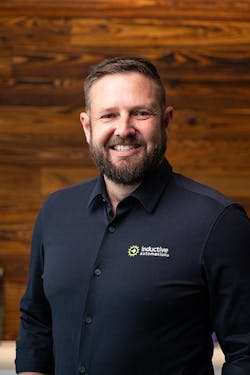Inductive Automation Looks to Help Industry Move Past OT Isolationism
Sept. 25, 2024
One thing that’s clear about the IT/OT convergence in manufacturing is that, when it comes to OT (operations technology) data, IT will likely have the final say in how it’s managed and transmitted beyond the factory floor. That’s why it’s critical for OT systems to be able to integrate well with IT’s systems.
Inductive Automation has long been an advocate for the ability of OT systems to play nice with IT and has been an increasingly vocal advocate as to why this approach makes sense for manufacturers of all sizes.
Two years ago, at Inductive Automation’s Ignition Community Conference, the company began positioning Ignition not just as an IoT platform for HMI and SCADA applications, but as a key piece of enterprise software. At the time, Travis Cox, chief technology evangelist at Inductive Automation explained, "Ignition is an enablement platform for the enterprise. It comes with a vast set of tools that enables customers to solve challenges and build larger solutions without limits. Ignition is an amazing IoT platform and an amazing SCADA platform, but we want customers to think outside the box and leverage it for far more. Ignition can be deployed virtually anywhere and can connect data, systems, people and cloud technologies together."
Carl Gould, chief technology officer, added, “Ignition allows you to create solutions that fit to your business’s digital transformation. But how can one product do that across industries? Is it SCADA? Is it IoT? The answer is: Yes. Ignition was designed to be run anywhere, connect anywhere and extend functionality as needed.”
This year, Inductive Automation expanded on this concept at its annual Ignition Community Conference to illustrate how Ignition serves as the bridge between IT and OT for applications that span the enterprise. These clarifications were made in advance of the company’s release of Ignition 8.3. This new release is planned for a Q1 2025 release with beta versions available in December 2024.
Creating an infrastructure vision
Calling Ignition 8.3 a “substantial release,” Colby Clegg, Inductive Automation’s CEO, highlighted three key aspects of the new version that are particularly relevant to the company’s positioning of Ignition as an IT/OT bridge: applications, a historian and an infrastructure approach. And it’s in the infrastructure aspects of 8.3 that Inductive Automation’s enterprise software vision is made clear.
“When building an HMI or a dashboard you probably don’t think about [software] infrastructure, but it’s key to the integration of OT and IT,” said Gould, explaining the company’s support for using IT software in the OT space. “It’s really about bringing these two worlds together that have vastly different engineering requirements.”
Clegg added that, of course, OT investments have to last longer than IT software investments but, from the IT side, IT and OT all have to be managed “as well-behaved systems—not isolated islands. And we are far beyond the time when OT can be isolated. If you want to achieve true convergence, you need a platform that bridges the requirements of both sides, and that’s what Ignition does.”
The new deployment infrastructure in 8.3 improves on existing containerization, orchestration and source control features. These features work most effectively when “the platform has native support for them,” said Clegg. “And with 8.3, we have the most IT-friendly SCADA system with all configurations managed in JSON text-based files for source control compatibility.”
No walled gardens
Pointing out that “walled gardens are not the answer” for future-capable industrial automation software, Clegg explained how Ignition’s new public historian API and Power Historian embedded in Ignition 8.3 will allow users to “leverage time series data on an enterprise scale from edge to cloud.”
By using SQL databases for Ignition’s historian, companies can use IT tools to store industrial data. This is all about using open data with industry standard tools that “your company is already familiar with,” Clegg said, noting that Inductive Automation’s history of SQL database use has led some to ask when the company will build a “real historian”.
Clegg said the company is not going the traditional industrial historian route and is sticking with SQL because of the large degree of innovation that has taken place in the consumer IT space for handling massive streams of time series data. “We want to be able to leverage IT systems in Ignition,” he said, “and the new public historian API (application programming interface) enables storage of metadata for advanced queries. So, it’s not just a historian, but a platform for building historians.”
Preliminary benchmarks on the data ingestion rate of Ignition’s new Power Historian shows it can handle far more than double the throughput of SQLite and mySQL.
Industry implementations
Highlighting Ignition’s varied implementation across industries, three key applications of Ignition were highlighted on the ICC’s opening day:
- CertainTeed, a manufacturer of building products, entered its digital transformation with several aging production systems—from an old manufacturing execution system to paper-based systems. To enable its digital transformation to begin with these legacy systems still in place, CertainTeed installed Ignition as an enterprise system to collect and share data from its production systems. This has enabled roaming operators to capture waste and downtime events and coordinate data flows between OT and IT systems. Ignition is now used at 15 CertainTeed plants with more installations planned.
- The baking division of the Goodman Fielder food company was held back in updating its operations software due to its extensive use of Excel worksheets, which were typically printed out for use. Using Ignition, Goodman Fielder was able to move recipe storage from its shop floor equipment to connect data and devices together, enabling recipes to be updated across the plant without having to stop production to install this capability.
- Spain’s Cinfa pharmaceutical company had a complex production system comprised of many disparate OT systems. Cinfa wanted an orchestrator of messages among these systems, not just a basic messaging system. They chose Ignition because of its ability to integrate with multiple systems and meet 21 CFR regulations.
Additional updates
Event Streams is another new feature of Ignition 8.3 that creates “a bus for data outside and inside Ignition,” said Clegg. This allows users to map event data from sources to handlers, giving them new ways to push, transform, filter and batch data.
Kevin McClusky, chief technology architect at Inductive Automation, noted that Event Streams will be a particularly big deal for companies using Kafka (an enterprise messaging system) to speak with other systems. “With Event Streams, users can move data without writing code,” he said, adding that it’s also useful for people “using Ignition for tag change scripts—as any change made will now allow for direct response inside Ignition.”
Ignition 8.3 also features support for Twilio and WhatsApp connectivity to send messages based on the communication apps Ignition users prefer.
Cox added that Ignition’s ease of connecting with outside systems underscores its capabilities as a single source of contextualized data for UNS (unified namespace) application.
He also noted that Ignition 8.3 includes an updated driver for Siemens S7 controllers due to the increasing popularity of Siemens controllers Inductive Automation is seeing among its customers. “With this driver, Ignition now connects immediately to Siemens S7 controllers and allows for tag browsing in the deployment of Siemens-based projects.”
Perspective is also getting a form component with an “offline mode” which enables it to work without gateway connectivity. Clegg said this means users can design an application that can work entirely offline, which is critical when doing remote work where connectivity isn’t possible. Once the user reconnects to their gateway, the data entered offline is submitted and synchronized across the system.
Leaders relevant to this article:






